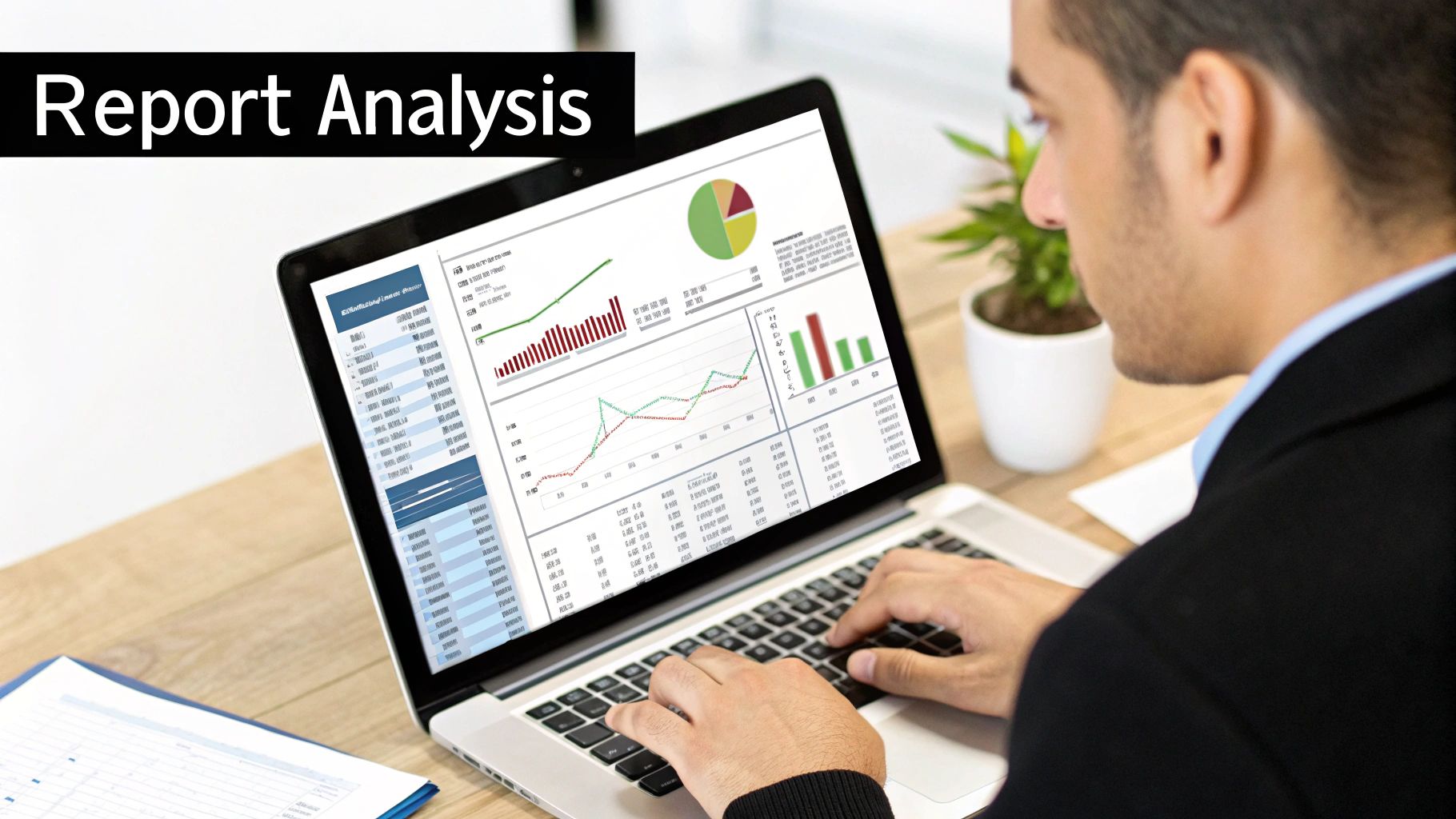What Is PnL? Breaking Down the Business Essentials

A Profit and Loss (PnL) statement, also known as an income statement, provides a snapshot of a company's financial performance over a specific period. It summarizes revenues, costs, and expenses to arrive at a final net profit or loss figure. Think of it as a business's report card, illustrating how effectively it generated profit from its operations. This information is essential for understanding a business's financial health.
For example, imagine a small bakery in London. Its PnL statement would show revenue from selling cakes and pastries, minus the costs of ingredients, rent, utilities, and staff wages. The resulting number reveals the bakery's profit (or loss) for that period. This allows the owner to assess the business's viability and make informed decisions about pricing, expenses, and future investments.
Why Is the PnL Statement Important, Especially in the UK?
The PnL statement serves several crucial functions, particularly for businesses operating in the UK. Primarily, it helps businesses track profitability and identify areas for improvement. By analyzing revenue streams and expenses, businesses can pinpoint inefficiencies and optimize operations. For instance, a UK retailer might use its PnL statement to assess the profitability of different product lines and subsequently adjust its inventory.
PnL statements are also crucial for UK businesses to comply with financial reporting standards. Profit and Loss (P&L) statements are essential for complying with standards such as the UK Generally Accepted Accounting Principles (UK-GAAP) or International Financial Reporting Standards (IFRS). For example, during the 2020-2021 financial year, many UK companies faced challenges due to the COVID-19 pandemic, significantly impacting their P&L accounts. A P&L statement typically lists revenues, the cost of goods sold, operating expenses, and net income.
This information is essential for stakeholders such as investors, management, and regulatory bodies like HMRC. UK companies must submit their P&L accounts as part of their tax obligations. Non-compliance can result in penalties. Discover more about UK P&L reporting requirements here. This legal compliance is vital for maintaining good standing with HMRC.
How Does the PnL Differ From Other Financial Statements?
While the PnL statement focuses on profitability over a period, other financial statements offer different perspectives. The balance sheet presents a snapshot of a company's assets, liabilities, and equity at a specific time. The cash flow statement tracks the movement of cash both into and out of a company during a specific period. These three statements work together to provide a comprehensive overview of a business's financial position.
Understanding the PnL allows UK businesses not only to meet regulatory requirements but also to make data-driven decisions for sustainable growth and success within the competitive UK market. Analyzing the PnL, along with the balance sheet and cash flow statement, provides a holistic view of financial performance, enabling businesses to identify trends, anticipate challenges, and capitalize on opportunities.
Mastering The Key Components Of Your PnL Statement

Understanding a profit and loss (PnL) statement goes beyond just looking at the final profit or loss figure. It involves a detailed examination of its key components to truly grasp your business's financial health. This in-depth analysis helps identify trends, spot potential issues, and ultimately, empower you to make data-driven decisions.
Revenue: More Than Just The Top Line
Revenue represents the income generated from your core business activities. For a UK retailer, this could be sales from physical stores and online channels. However, simply combining all revenue isn't sufficient. Successful businesses strategically segment their revenue streams.
This might involve separating online sales from brick-and-mortar sales, or categorizing revenue by product type. This granular view helps pinpoint high-performing areas and those needing improvement.
For instance, declining in-store sales might suggest a need to enhance the in-store customer experience. Conversely, a surge in online sales could signal the need for scaling online operations. These insights are vital for strategic planning.
Cost Of Goods Sold (COGS): Understanding Your Direct Costs
Cost of Goods Sold (COGS) encompasses the direct costs associated with producing goods or services. This includes raw materials, direct labor, and manufacturing overhead. For a UK clothing brand, COGS might include the cost of fabrics, seamstress wages, and factory rent.
Accurate COGS calculation is crucial for determining gross profit, a key profitability indicator. A rising COGS without a corresponding revenue increase could indicate production inefficiencies and shrinking profit margins. This is a critical area to monitor closely.
Operating Expenses: Keeping The Lights On
Operating expenses, often referred to as Selling, General, and Administrative Expenses (SG&A), are the costs incurred to run your business. These indirect costs aren't directly tied to production, such as rent, utilities, marketing, and administrative staff salaries.
A UK tech startup's operating expenses might include London office space, UK-targeted marketing campaigns, and management team salaries. Analyzing operating expenses is essential for gauging operational efficiency. A high SG&A percentage relative to revenue might reveal areas for cost optimization.
Putting It All Together: From Gross Profit To Net Profit
Understanding the relationship between these components is crucial for accurate PnL interpretation. Gross profit, calculated as Revenue – COGS, shows the profitability of core operations. Subtracting operating expenses from gross profit yields operating income, revealing profitability before interest and taxes.
Finally, deducting interest and taxes gives you net profit, the bottom line. To provide further clarity, let's examine a table summarizing the key components of a PnL statement.
To further illustrate these key components and their significance in driving business decisions, let's examine the following table:
PnL Statement Components That Drive Decisions
A comprehensive breakdown of the essential PnL elements, their strategic importance, and what they reveal about business performance opportunities
| Component | Definition | Business Insight |
|---|---|---|
| Revenue | Income from sales of goods and services | Overall sales performance and growth trends |
| COGS | Direct costs of producing goods or services | Efficiency of production and impact on profitability |
| Operating Expenses | Indirect costs of running the business | Operational efficiency and areas for potential cost savings |
| Gross Profit | Revenue – COGS | Profitability of core business operations |
| Operating Income | Gross Profit – Operating Expenses | Profitability before interest and taxes |
| Net Profit | Final profit after all expenses are deducted | Overall profitability of the business |
This table clearly highlights how each element of the PnL statement offers valuable insights into different facets of business performance. By analyzing these components, businesses can identify areas of strength and weakness, allowing them to make informed decisions to improve profitability and overall financial health.
By mastering these key components, you'll gain a profound understanding of what a PnL statement represents. You'll unlock its potential to inform your business strategies in the UK market. This empowers you to move beyond simply reading the numbers to actively utilizing them for driving growth and success.
PnL and UK Tax Compliance: Beyond the Basics

Successfully navigating the complexities of UK tax law requires a firm grasp of how your profit and loss (PnL) statement influences your tax obligations. A well-structured PnL statement is more than just a record of finances; it's the foundation for precise tax calculations and adherence to HMRC regulations. This means understanding not only what a PnL statement is, but also its significance within the UK's distinct regulatory framework.
HMRC Requirements and Deadlines
Her Majesty's Revenue and Customs (HMRC) sets specific requirements for how PnL statements should be formatted and submitted. These guidelines ensure consistency and transparency in financial reporting for all UK businesses. Missing deadlines can result in penalties, making awareness of these requirements critical. Furthermore, diligent record-keeping throughout the year simplifies the often-daunting year-end reporting process.
For example, UK companies must adhere to specific accounting standards, often UK-GAAP, when preparing their PnL statements for tax purposes. These standards dictate how revenue and expenses are recognized and classified. HMRC also mandates the electronic filing of company tax returns, including the PnL statement, emphasizing the importance of digital record-keeping solutions.
A key aspect of P&L statements in the UK is their function in ensuring tax compliance. Businesses must submit their P&L accounts to HMRC annually, and these statements form the basis for calculating corporation tax liabilities. For example, in 2022, many UK companies experienced increased tax obligations due to a rise in profitability after the pandemic. The P&L statement details sales revenue, cost of goods sold, and various expenses, which together determine net profits. This net profit figure is then used to calculate the taxes owed. Properly prepared P&L accounts must also comply with specific UK accounting standards to guarantee accuracy and consistency. Explore this topic further here.
Common PnL Mistakes and How to Avoid Them
Several common errors in PnL preparation can attract unwanted attention from HMRC. Inconsistent revenue recognition, incorrectly categorized expenses, and insufficient documentation are frequent issues. These mistakes not only lead to potential penalties, but they also consume valuable time and resources that could be better spent elsewhere.
Implementing robust accounting software can help mitigate these risks. Software solutions can automate data entry, categorize transactions accurately, and generate compliant PnL statements with minimal effort. Some software also offers predictive modeling capabilities, further assisting in forecasting costs, including taxes, and allowing for proactive financial management.
Transforming Tax Compliance into a Strategic Advantage
Forward-thinking UK businesses understand that tax compliance isn't merely a mandatory task; it's a strategic opportunity. By proactively managing their PnL statements, companies gain valuable insights into their overall financial performance. This information enables strategic planning, cost optimization, and ultimately, improved profitability.
Moreover, maintaining accurate and organized financial records empowers businesses to negotiate more favorable terms with suppliers, secure financing, and attract investors. This proactive approach transforms tax compliance from a reactive obligation into a driver of growth and success in the competitive UK market. Through meticulous record-keeping and detailed analysis, businesses can unlock the strategic potential of their PnL statement, positioning themselves for continued growth and success.
Transforming PnL Data Into Strategic Decisions

Understanding what a profit and loss (P&L) statement is is only the beginning. The real power lies in using it to inform strategic decisions and drive business growth, especially in a competitive market like the UK. Progressive companies don't simply see their P&L as a reporting obligation; they recognize it as a valuable tool for achieving a competitive advantage.
Identifying Hidden Profit Leaks and Opportunities
A thorough P&L analysis can reveal hidden profit drains that might otherwise go unnoticed. For instance, a UK restaurant chain could analyze its P&L to pinpoint menu items with low profit margins. This information could then lead to menu adjustments, sourcing different ingredients, or even implementing targeted marketing campaigns to boost profitability.
Examining trends in operating expenses can also highlight areas for cost optimization. This could involve renegotiating contracts with suppliers, implementing energy-saving measures, or streamlining administrative processes. These insights can lead to significant improvements to the bottom line. P&L statements are essential for broader business decisions within the UK. They provide valuable insights into profitability ratios, such as gross and net profit margins, helping companies assess operational efficiency.
A UK retail chain, for example, might use its P&L to identify opportunities for cost savings or adjust pricing strategies. This is particularly important in competitive environments where even small margin improvements can significantly impact overall profits. Investors also use P&L statements to evaluate a company's performance over time by comparing year-on-year changes in revenue and expenses. More detailed statistics on P&L statements can be found here.
Evaluating Product Line Performance and Forecasting
P&L data allows businesses to precisely evaluate the performance of individual product lines by analyzing the revenue and costs associated with each product or service. A UK online retailer selling electronics, for example, could use its P&L to determine which product categories are the most profitable and which are underperforming.
This knowledge is crucial for informed inventory management and future product development decisions. Furthermore, historical P&L data provides a foundation for forecasting future performance. By analyzing past revenue and expense trends, businesses can create realistic financial projections and anticipate potential challenges.
These forecasts are critical for securing funding, attracting investment, and making well-informed strategic choices.
Serving Multiple Stakeholders Effectively
Different stakeholders derive different value from the same P&L statement. Operations managers are primarily focused on cost control and efficiency, while investors are more interested in profitability and growth potential.
It's therefore vital to structure P&L analysis to serve multiple audiences effectively. This involves creating tailored reports that highlight the key metrics relevant to each stakeholder group. For instance, a detailed breakdown of operating expenses would be useful for operations managers, whereas a summary of key profitability ratios and growth trends would be more pertinent for investors.
This targeted approach ensures each stakeholder receives the insights they need. By understanding these diverse needs and presenting the information clearly, businesses can maximize the power of their P&L to drive alignment across the organization. This shared understanding of financial performance helps unify efforts towards common goals, fostering a culture of data-driven decision-making.
What Is PnL in Financial Markets? A Deeper Dive
Profit and Loss (PnL) reporting in financial markets goes beyond basic business accounting. It represents the daily change in a portfolio's value, providing a real-time snapshot of performance. Investment professionals, especially in the UK, use daily PnL reports to manage their portfolios and respond to market fluctuations.
Realized vs. Unrealized PnL: A Critical Distinction
Understanding the difference between realized and unrealized PnL is essential. Realized PnL reflects profits or losses from completed trades—positions that have been closed. Unrealized PnL, on the other hand, represents potential profit or loss on open positions, fluctuating with market conditions.
For example, if a trader in the UK buys shares on the London Stock Exchange and the price rises, they have unrealized PnL until they sell those shares, locking in the profit. This distinction impacts how traders assess their financial position and informs their trading strategies.
Mark-to-Market Accounting and True Performance
Mark-to-market accounting is a common practice in financial markets. It values assets at their current market price, not the original purchase price. This method provides a more accurate reflection of a portfolio's value in dynamic market conditions.
This practice is particularly important in the UK, given the active nature of the London Stock Exchange and other UK financial markets. Mark-to-market accounting ensures transparency and provides a realistic view of a portfolio's current worth.
Attribution Analysis: Unraveling Performance Drivers
Attribution analysis provides a deeper understanding of PnL. This process breaks down performance to pinpoint the contributions of specific strategies, asset classes, or individual securities. This helps investment professionals understand which strategies are genuinely effective and which are simply riding market trends. This granular analysis is key for optimizing investment decisions.
PnL Explained Reports: Detailed Insights
In UK investment banking, PnL explained reports are crucial for understanding daily portfolio value fluctuations. These reports offer detailed attribution of value changes, linking them to factors like changes in commodity prices, interest rates, and volatility. This granular detail is essential for risk management and regulatory compliance.
For example, during volatile periods like the early stages of the COVID-19 pandemic, PnL explained reports helped UK financial institutions understand and mitigate risk exposures. This ensures that financial models are accurate and consistent with market conditions. For more detailed information, see PnL Explained.
Risk Management and Regulatory Compliance
Risk managers use PnL reports to identify and mitigate potential risks. Understanding daily fluctuations enables them to implement hedging strategies or adjust positions to limit exposure.
Furthermore, UK regulatory requirements, often aligned with European and global standards, emphasize transparency in financial reporting. Detailed PnL reports are vital for demonstrating compliance, promoting stability within the UK financial system, and protecting investors.
Building Your First Powerful PnL Statement
Creating a profit and loss (PnL) statement can feel overwhelming, but it doesn't have to be. This guide provides a practical, step-by-step approach for UK small business owners to build their first PnL.
Gathering Your Financial Data: A Practical Approach
The first step involves gathering all your financial data. This includes every bit of revenue generated and all expenses incurred during the period you are analyzing. For a monthly PnL, collect all sales invoices and expense receipts for that month. Digital tools like spreadsheets or accounting software can help organize this data, especially for UK businesses with fluctuating income, such as freelancers or seasonal operations.
Organizing Your Data: The Key to Insight
Once collected, organize your data into the appropriate categories. This typically means separating revenue streams and categorizing expenses. For UK businesses, accurate expense categorization is vital for proper tax calculations and compliance with HMRC regulations. Common questions for UK entrepreneurs include how to classify home office or vehicle expenses. Consistent and accurate categorization ensures your PnL offers valuable insights.
Calculating Key Metrics: Driving Better Decisions
With organized data, you're ready to calculate the key metrics of your PnL statement. These metrics provide a complete overview of your business's financial performance.
- Revenue: Your total income from sales.
- Cost of Goods Sold (COGS): The direct costs tied to producing your goods or services.
- Gross Profit: Calculated as Revenue – COGS.
- Operating Expenses: The indirect costs of running your business.
- Operating Income: Gross Profit – Operating Expenses.
- Net Profit: The final profit after deducting all expenses, including taxes and interest.
Understanding these figures is essential for informed decision-making in pricing, cost management, and investments.
Software Solutions for UK Businesses
Several affordable software solutions can simplify PnL creation and maintenance. For UK businesses, compliance with UK-GAAP or IFRS standards is essential when choosing software. Popular options include Xero, QuickBooks, and FreeAgent. These platforms automate data entry, ensure accurate calculations, and often generate HMRC-compliant reports, saving time and resources.
Addressing Common UK Business Challenges
UK entrepreneurs often face challenges like irregular income, expense categorization, and complex tax rules. A well-structured PnL can address these directly. Tracking revenue streams individually allows businesses to understand income patterns and forecast future revenue. Careful expense categorization, guided by HMRC resources, ensures accurate tax calculations.
Building a UK Small Business PnL Blueprint
The following table provides a simplified PnL template for a UK-based online retailer. This illustrates how a PnL can reveal key profitability insights.
To better illustrate this process, here’s a practical template you can use:
UK Small Business PnL Blueprint
A comprehensive template designed specifically for UK small businesses with practical examples and calculations for immediate implementation
| Line Item | Formula/Calculation | Example (£) |
|---|---|---|
| Revenue | Total Sales | 10,000 |
| COGS | Cost of Products Sold + Shipping | 4,000 |
| Gross Profit | Revenue – COGS | 6,000 |
| Operating Expenses | Website Hosting + Marketing + Administrative Costs | 2,000 |
| Operating Income | Gross Profit – Operating Expenses | 4,000 |
| Corporation Tax (Assume 19%) | Operating Income * 0.19 | 760 |
| Net Profit | Operating Income – Corporation Tax | 3,240 |
This example demonstrates how a simple PnL offers valuable insights. Imagine further segmenting revenue by product lines to understand which products contribute most to your bottom line.
By following these steps and using the right tools, building a powerful PnL becomes manageable and insightful for any UK business. This foundation allows for data-driven decisions, leading to financial clarity and business success.
Ready to transform your TikTok Shop sales data into actionable insights? Mergoio, a profit-tracking software for e-commerce sellers, offers real-time analytics and a comprehensive dashboard. Explore how Mergoio can help your business grow.

Leave a Reply